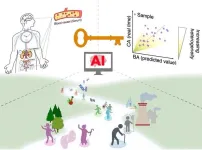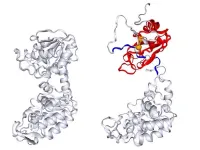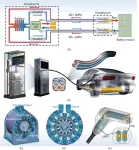(Press-News.org) EMBARGOED until Friday, March 14 at 2:00 p.m. Eastern Time (12 noon MT)
Contacts:
David Hosansky, NSF NCAR and UCAR Manager of Media Relations
hosansky@ucar.edu
303-497-8611
Audrey Merket, NSF NCAR and UCAR Science Writer and Public Information Officer
amerket@ucar.edu
303-497-8293
The smoke from fires that blaze through the wildland-urban interface (WUI) has far greater health impacts than smoke from wildfires in remote areas, new research finds.
The study, published this week in Science Advances, estimates that emissions from WUI fires are proportionately about three times more likely to lead to annual premature deaths than emissions from wildfires in general. This is because the fires, and their associated emissions, are far closer to populated areas.
The work was conducted by an international team of researchers, led by scientists at the U.S. National Science Foundation National Center for Atmospheric Research (NSF NCAR). The study drew on a database of WUI fires and advanced computer modeling techniques.
“Even though the emissions of WUI fires are relatively small globally, the health impacts are proportionately large because they’re closer to human populations,” said NSF NCAR scientist Wenfu Tang, the lead author. “Pollutants emitted by WUI fires such as particulate matter and the precursors to ozone are more harmful because they’re not dispersing across hundreds or thousands of miles.”
The study was funded by NOAA and NSF.
The spread of WUI fires
The wildland-urban interface is the geographic area where wildland vegetation and developed land come together or intermingle. WUI areas have been expanding on all populated continents and now constitute about 5% of the world’s land area, excluding Antarctica.
With this expansion have come devastating fires. Some of the deadliest WUI blazes in recent years include the 2009 Black Saturday bushfires in Australia that directly killed 173 people, the 2018 Attica fires in Greece that killed 104, and the 2023 Lahaina Fire in Hawaii that killed 100. At the beginning of this year, a disastrous outbreak of fires in Southern California burned an estimated 16,000 homes, businesses, and other structures, with estimates of financial losses ranging up to $250 billion or higher.
A previous study led by Tang used satellite observations and machine learning techniques to show that the fraction of global fires that occur in WUI areas has increased significantly this century.
Building on that work, Tang and her colleagues wanted to estimate the health effects of the fire emissions beyond the immediate deaths. Certain pollutants associated with smoke, such as fine particulate matter and ground-level ozone, are especially harmful to cardiovascular and respiratory systems.
The researchers turned to an advanced NSF NCAR–based computer model, the Multi-Scale Infrastructure for Chemistry and Aerosols (MUSICA), to simulate pollutants from fires. Their modeling included carbon monoxide chemical tracers, which enabled them to estimate the sources of emissions and differentiate between wildland and WUI fires.
They also used a dataset of WUI fires in the recent two decades worldwide, which Tang and her colleagues developed last year.
To compare emissions of WUI fires with those from wildland fires, the researchers simulated four scenarios. These consisted of: no fires, both WUI and wildland fires, WUI fires only, and wildland fires only. The difference between all fires and just wildland fires indicated the impacts of WUI fire emissions.
The results showed that WUI fire emissions constituted 3.1% of all fire emissions across the six populated continents in 2020. However, the fractional contribution of WUI fire emissions to premature deaths was 8.8% of all fire emissions because of how many people were affected by smoke from WUI fires.
The numbers varied by continent depending on the proximity of dense populations to WUI fires. In North America, for example, WUI fires represented 6% of all fires and 9.3 % of premature deaths from emissions. In Europe, however, those numbers were 11.4% and 13.7%, respectively.
A critical factor that Tang wants to examine next is the difference in emissions from wildland fires that consume trees and other vegetation as opposed to WUI fires that burn down structures that often contain additional toxic substances. The smoke from different burned materials may have widely varying impacts on human health.
“It is very important to have an emission inventory that explicitly accounts for the burning of structures,” Tang said. “We need to know what is being burned in order to determine what is going up in smoke.”
About the study
Title: Disproportionately large impacts of wildland-urban interface fire emissions on global air
quality and human health
Authors: Wenfu Tang, Louisa K. Emmons, Christine Wiedinmyer, Debatosh B. Partha, Yaoxian
Huang, Cenlin He, Junzhe Zhang, Kelley C. Barsanti, Benjamin Gaubert, Duseong S.
Jo, Jun Zhang, Rebecca Buchholz, Simone Tilmes, Francis Vitt, Claire Granier, Helen M. Worden, and Pieternel F. Levelt
Publication: Science Advances
This material is based upon work supported by the NSF National Center for Atmospheric Research, a major facility sponsored by the U.S. National Science Foundation and managed by the University Corporation for Atmospheric Research. Any opinions, findings and conclusions or recommendations expressed in this material do not necessarily reflect the views of NSF.
END
Smoke from wildland-urban interface fires more deadly than remote wildfires
Emissions are proportionately three times more likely to lead to premature deaths
2025-03-14
ELSE PRESS RELEASES FROM THIS DATE:
What’s your body really worth? New AI model reveals your true biological age from 5 drops of blood
2025-03-14
Osaka-Japan - We all know someone who seems to defy aging—people who look younger than their peers despite being the same age. What’s their secret? Scientists at Osaka University (Japan) may have found a way to quantify this difference. By incorporating hormone (steroid) metabolism pathways into an AI-driven model, they have developed a new system to estimate a person’s biological age a measure of how well their body has aged, rather than just counting the years since birth.
Using just five drops of ...
Protein accidentally lassos itself, helping explain unusual refolding behavior
2025-03-14
UNIVERSITY PARK, Pa. — Proteins are long molecules that must fold into complex three-dimensional structures to perform their cellular functions. This folding process occasionally goes awry, resulting in misfolded proteins that, if not corrected, can potentially lead to disease. Now, a new study has described a potential mechanism that could help explain why some proteins refold in a different pattern than expected. The researchers, led by chemists at Penn State, found that a type of misfolding, in which the ...
With bird flu in raw milk, many in U.S. still do not know risks of consuming it
2025-03-14
PHILADELPHIA – Although the Food and Drug Administration (FDA) located H5N1 bird flu virus in samples of raw, or unpasteurized, milk in tests in four states in April 2024, and bird flu has been detected in commercially sold raw milk, many Americans do not know that consuming raw milk and its products poses greater health risks than consuming pasteurized milk and its products, especially for children. Consuming raw milk can expose one to Salmonella, E. coli, Campylobacter, Cryptosporidium, Listeria, and Brucella – and, potentially, H5N1 bird flu.
A majority of U.S. adults (56%) knows that drinking raw milk from cows, sheep, or goats is less safe than drinking pasteurized milk. ...
University of Minnesota research team awarded $3.8 million grant to develop cell therapy to combat Alzheimer’s disease
2025-03-14
MINNEAPOLIS/ST. PAUL (03/14/2025) — A University of Minnesota research team was recently awarded a five-year, $3.8 million grant from the U.S. National Institutes of Health to develop a new cell therapy to combat Alzheimer’s disease. More than 55 million people worldwide live with dementia, which includes Alzheimer's disease and other related conditions.
The project aims to adapt advanced techniques developed for cancer treatment to create specialized macrophages — immune cells that can surround and remove proteins from their environment — to seek out and clear harmful proteins in the brain.
"Engineered ...
UConn uncovers new clue on what is leading to neurodegenerative diseases like Alzheimer’s and ALS
2025-03-14
In Nature Neuroscience, UConn School of Medicine researchers have revealed a new scientific clue that could unlock the key cellular pathway leading to devastating neurodegenerative diseases like Alzheimer’s disease, and the progressive damage to the brain’s frontal and temporal lobes in frontotemporal degeneration (FTD) and the associated disease amyotrophic lateral sclerosis (ALS).
The study, “Endothelial TDP-43 Depletion Disrupts Core Blood-Brain Barrier Pathways in Neurodegeneration,” was published on March 14, 2025. The lead author, Omar Moustafa Fathy, an MD/Ph.D. candidate at the Center for Vascular Biology at UConn School of ...
Resuscitation in out-of-hospital cardiac arrest – it’s how quickly it is done, rather than who does it
2025-03-14
Key takeaways:
The proportion of bystanders (as opposed to emergency medical services) performing cardiopulmonary resuscitation (CPR) on individuals experiencing out-of-hospital cardiac arrest (OHCA) has steadily increased over the past decades.
The study emphasises that the speed of CPR initiation, rather than who performs it, is crucial to survival and better outcomes.
Each 5-minute delay in return of spontaneous circulation in patients experiencing OCHA is associated with a 38% increased risk of death.
Based on these findings, the authors emphasise that increasing the number of individuals trained in proper CPR ...
A closer look at biomolecular ‘silly putty’
2025-03-14
Biomolecular condensates are shifting blobs in our cells that organize cellular matter. They are distinct molecular communities made of DNA, RNA and proteins that “condense” molecules to key locations, yet they frequently defy description. Partly this is because they are so small, they cannot be measured using traditional microscopes.
“These blobs were once described as being ‘liquid-like’ because some of them were observed to kiss, fuse, drip and flow like raindrops on windshields,” said Rohit Pappu, Gene K. Beare Distinguished Professor of biomedical engineering ...
Oxytocin system of breastfeeding affected in mothers with postnatal depression
2025-03-14
The oxytocin system – which helps release breast milk and strengthens the bond between mother and baby – may be affected during breastfeeding in mothers experiencing postnatal depression, finds a new study by UCL researchers.
The new research, published in Psychoneuroendocrinology, investigated the link between maternal mood and the oxytocin pathway during breastfeeding, in mothers with and without symptoms of postnatal depression.
Oxytocin is a hormone that is released in both the brain and body. It plays a central role in childbirth and breastfeeding, ...
Liquid metal-enabled synergetic cooling and charging: a leap forward for electric vehicles
2025-03-14
A recent study published in Engineering presents a novel approach to address the challenges of high-power direct current fast charging (DC-HPC) in electric vehicles (EVs). The research, led by a team from China Agricultural University, focuses on developing a synergetic cooling and charging strategy using a gallium-based liquid metal flexible charging connector (LMFCC).
As the demand for EVs grows, DC-HPC technology, especially for megawatt-level charging currents (≥1000 A), is crucial for reducing charging time. However, it brings the ...
Defensive firearm use is far less common than exposure to gun violence
2025-03-14
Those with access to firearms rarely use their weapon to defend themselves, and instead are far more likely to be exposed to gun violence in other ways, according to a Rutgers Health study.
An overwhelming majority of firearm users, or about 92%, indicated they never have used their weapons to defend themselves, with less than 1% say they did in the previous year, a new study by the New Jersey Gun Violence Research Center found.
“Adults with firearm access are far more likely to be exposed to gun violence than they are to defend themselves with their firearms,” ...
LAST 30 PRESS RELEASES:
SIMJ announces global collaborative book project in commemoration of its 75th anniversary
Air pollution exposure and birth weight
Obstructive sleep apnea risk and mental health conditions among older adults
How talking slows eye movements behind the wheel
The Ceramic Society of Japan’s Oxoate Ceramics Research Association launches new international book project
Heart-brain connection: international study reveals the role of the vagus nerve in keeping the heart young
Researchers identify Rb1 as a predictive biomarker for a new therapeutic strategy in some breast cancers
Survey reveals ethical gaps slowing AI adoption in pediatric surgery
Stimulant ADHD medications work differently than thought
AI overestimates how smart people are, according to HSE economists
HSE researchers create genome-wide map of quadruplexes
Scientists boost cell "powerhouses" to burn more calories
Automatic label checking: The missing step in making reliable medical AI
Low daily alcohol intake linked to 50% heightened mouth cancer risk in India
American Meteorological Society announces Rick Spinrad as 2026 President-Elect
Biomass-based carbon capture spotlighted in newly released global climate webinar recording
Illuminating invisible nano pollutants: advanced bioimaging tracks the full journey of emerging nanoscale contaminants in living systems
How does age affect recovery from spinal cord injury?
Novel AI tool offers prognosis for patients with head and neck cancer
Fathers’ microplastic exposure tied to their children’s metabolic problems
Research validates laboratory model for studying high-grade serous ovarian cancer
SIR 2026 delivers transformative breakthroughs in minimally invasive medicine to improve patient care
Stem Cell Reports most downloaded papers of 2025 highlight the breadth and impact of stem cell research
Oxford-led study estimates NHS spends around 3% of its primary and secondary care budget on the health impacts of heat and cold in England
A researcher’s long quest leads to a smart composite breakthrough
Urban wild bees act as “microbial sensors” of city health.
New study finds where you live affects recovery after a hip fracture
Forecasting the impact of fully automated vehicle adoption on US road traffic injuries
Alcohol-related hospitalizations from 2016 to 2022
Semaglutide and hospitalizations in patients with obesity and established cardiovascular disease
[Press-News.org] Smoke from wildland-urban interface fires more deadly than remote wildfiresEmissions are proportionately three times more likely to lead to premature deaths




